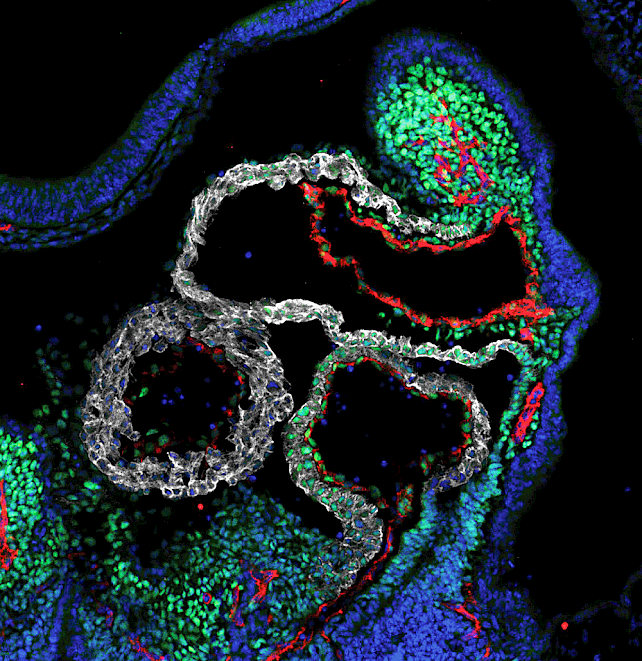Harnessing Single-Cell Technologies to Map Cardiac Development
Dr. Marco Osterwalder’s lab at the University of Bern in Switzerland combines molecular genetics and functional genomics to investigate gene regulation and the transcriptional enhancer landscapes underlying heart development and disease. Genevia Technologies was proud to support this research by providing advanced data analysis expertise for projects involving bulk RNA-seq and 10x Multiome data.
 A mouse embryonic heart from which the 10x Multiome data was generated. Cell nuclei are in blue, myocardium in gray, endothelial cells in red, and nuclei expressing the Hand2 cardiac transcription factor are in green.
A mouse embryonic heart from which the 10x Multiome data was generated. Cell nuclei are in blue, myocardium in gray, endothelial cells in red, and nuclei expressing the Hand2 cardiac transcription factor are in green.
From Limb Development to the Complexities of the Heart
Dr. Marco Osterwalder’s fascination with developmental biology began during his PhD studies at the University of Basel in the lab of Prof. Rolf Zeller, where he explored transcription factor networks in limb development. His interest in gene regulation deepened during his postdoctoral research at Lawrence Berkeley National Laboratory in California, in the renowned lab of Dr. Axel Visel and Dr. Len Pennacchio. There, he focused on identifying transcriptional enhancers across the genome:
“In mammals, many enhancers and their functions are conserved, but at the time, it was not yet well known in which areas of the genome they are present and what each individual enhancers’ function would be. We used genome-wide techniques in bulk tissues of mouse embryos to try and figure out the patterns of transcription factor binding and chromatin signatures to better predict tissue-specific enhancers, which were then validated using in vivo reporter assays,” he explains. “That’s when I started to focus more and more on the heart; it’s such a fascinating organ, and a little more complex in its development than the limb.”
Dr. Osterwalder was particularly intrigued by the diversity of cell types and cell state transitions contributing to the heart and their intricate roles in forming its four-chambered structure. These complexities laid the foundation for his current research focus.
After completing his postdoc, Dr. Osterwalder received a career development grant and returned to Switzerland to establish his own lab at the University of Bern. Today, his team focuses on understanding transcriptional regulation and gene networks during cardiac development—critical knowledge for improving the diagnosis, prevention, or eventual treatment of congenital heart disease (CHD).
A Timely Collaboration with Genevia Technologies
In late 2022, Dr. Osterwalder’s path crossed with Genevia Technologies at a pivotal moment. The lab was exploring analysis options for datasets generated through the 10x Multiome platform: a cutting-edge technology for simultaneous analysis of RNA and chromatin accessibility at the single-cell level. However, it quickly became clear that specialized expertise would be ideal to fully harness its potential.
As luck would have it, Genevia’s CEO, Antti Ylipää, was visiting Bern around the same time. A meeting was arranged, and a fruitful collaboration soon followed.
Dr. Grigorios Georgolopoulos, Genevia’s Scientific Project Manager (and now Chief Operating Officer), supported Dr. Osterwalder’s team through two projects. The first involved bulk RNA-seq analysis which—despite some challenges with the data and the need for batch correction—was completed efficiently.
The second, and more complex, project focused on 10x Multiome data from mouse embryonic hearts at three developmental stages. Given the novelty of the technology, this required advanced expertise across the entire workflow: quality control, preprocessing of RNA and ATAC-seq data, peak calling, trajectory analysis, and motif analysis.
“This collaboration was a very exciting time for us,” says Dr. Osterwalder. “Grigorios is extremely knowledgeable, and we enjoyed working with him. He explored the best approaches for several steps, and the results revealed some very intriguing cardiac cell type-specific signatures. These data sets have become a rich resource for us allowing to predict developmental heart enhancer elements at much higher precision. Very importantly, the documented code and processed data objects were shared with us, allowing to independently mine the data ourselves, and to easily share the results with collaborators. We’re indeed currently wrapping up a manuscript including this work for submission.”
A True Scientific Partnership
For Dr. Osterwalder, the success of the collaboration came down to more than just technical competence. What set Genevia Technologies apart was their scientific understanding of his specific field.
“Genevia exceeded the possibilities of our local core in terms of specialization. While we also have very good bioinformaticians here, their focus is less specific and it would take much longer to explain to them what we actually need,” he says. “With Genevia, it felt like we actually had a true collaborator. Grigorios could discuss the science with us at the same depth.”
He also praises the quality and reliability of the collaboration: “Efficiency and quality were excellent. There were no waiting times or delays; all of our requests were incorporated. Communication and all practicalities were always straightforward and seamless.”
Another highlight was Genevia’s flexible service model: “Being able to pause and resume with additional bookings as needed is definitely helpful.”
Reflecting on the partnership, he concludes:
“It felt exactly like collaborating with a scientific colleague, or even hiring a scientist from a top lab in functional genomics. Everything went smoothly, and we truly enjoyed the experience. As soon as we feel we lack the expertise to get the most out of our data, we’ll definitely consider working with Genevia again.”
Contact us
Leave us a message below if you would like to hear how we can help you.
